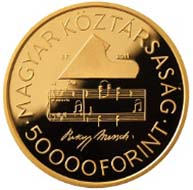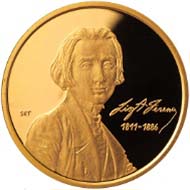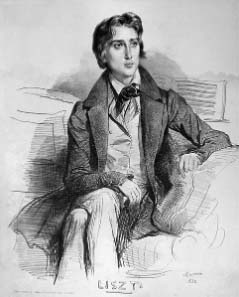October 27, 2011 – The Magyar Nemzeti Bank issued two commemorative coins, one in gold and one as piedfort, to honor Franz Liszt. The great Austro-Hungarian composer was a student of Chopin and Paganini, and was born 200 years ago in an Hungarian village.
Hungary – 50000 HUF – 986 gold – 6.982 g – 22 mm – Mintage: 5,000 pieces.
Marking the bicentennial anniversary of Liszt’s birthday, the Magyar Nemzeti Bank (Hungary’s central bank) issued a gold commemorative coin. Designed by Tamás E. Soltra, the coin depicts Liszt as a young man, on the basis of the portrait by Ingres. The front of the coin features the legend “Rakoczi Marsch” under a piano lid, a quote from the sheet music of the Rákóczi March, in the style of Liszt’s handwriting.
The coin was also struck as a piedfort (mintage: 1,500 pieces), with the legend “Mint magyar hazámnak hü fia: Liszt Ferenc” (As a loyal son of the Hungarian nation: Ferenc Liszt) around the edge.
One of the greatest pianists of all times and a master of Romanticism, Franz Liszt was born on 22 October 1811 in the village of Doborján (present-day Raiding in Austria), in the county of Sopron, Hungary. He was an incredibly impressive pianist, a bold, ground-breaking composer, a masterful conductor and a widely-respected teacher and writer on the subject of music.
His extraordinary musical talent emerged at a very early age. In 1822, he became a student of Czerny and Salieri in Vienna. In December 1823, he moved to Paris, where he learned the subtleties of piano playing from Chopin, the art of conducting and the latest developments in symphonic music from Berlioz, and was moved to perfect his technique on the piano by the virtuoso violin playing of Paganini.
The years in Paris made a lasting impression on Liszt as he developed from a child genius giving concerts and composing to become a grown man. He transformed himself into an accomplished artist through constant practice, reading and work. Composing began to become an increasingly important part of his work.
Franz Liszt, lithography by Deveria, 1832.
In 1833, he met his great love and first partner, the Countess Marie D’Agoult. They lived in Switzerland and Italy, bringing three children into the world. His almost-forgotten Hungarian roots came to mind again as a result of the great flood of Pest in 1838, when he gave a massively successful series of benefit concerts for the flood victims in Vienna. Already a renowned musician, he first returned to Hungary at the turn of 1839/40, where he premiered as a conductor and was awarded a ceremonial sabre on behalf of the nation for his patriotism. In 1844, Liszt and Marie D’Agoult finally parted ways and their relationship ended.
On a concert tour of Russia in 1847, he met his new love, the Princess Carolyne von Sayn-Wittgenstein. His last decades were spent divided between Weimar, Rome and Budapest, and were dominated by art, religion and his relationship with Princess Carolyne. In 1865, Liszt received the four minor orders of the church. He was elected the first President of the Hungarian Royal Music Academy. He donated the most beautiful souvenirs from his musical career to the National Museum of Hungary, and his last home in Budapest is now the Franz Liszt Memorial Museum. He died on 31 July 1886 in Bayreuth of pneumonia.
To listen to the “Rakoczi Marsch”, please click here.
Because of his importance for the German land Thuringia where Liszt had lived and worked for some years, Thuringia also commemorates Liszt’s birthday in 2011 themed “Franz Liszt 1811-1886. A European in Thuringia.” To get more information on this project, visit this site.
2







